|
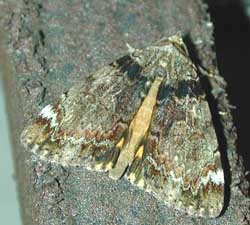
| ** 8874 Catocala minuta TM; Little Underwing, 35-45mm; Fw grey-brown, greatly widened, white, st line (near costa only). Hw outer black band unbroken, inner band in complete loop, brown scaling along im. "eureka" Schwarz: blackish area between am,pm lines; "hiseri" Cassino: dull grey fw, very faint markings; "mellitula" Hulst: blackish patch in basal area from costa to im; "obliterata" Schwarz: melanic form, almost completely black fw; "parvula" W. H. Edwards: broad dark patch along fw i. m.. |
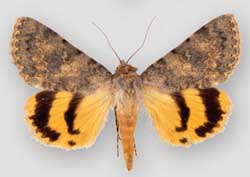
| Catocala frederici;
Frederic's Underwing: 40-52mm:
Fw blotchy yellow-brown, faint lines. Double am line has large central lobe.
Subrenifrom spot closed and pale.
Submarginal area orangey-yellow.
Hw yellow-orange, with outer black band broken, followed by flattened dot.
Thin inner black band angles almost 90 degree, truncated
well before im. Apex, large yellow area.
|
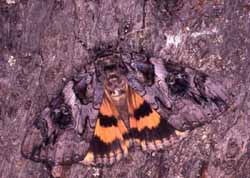 |
** 8844 amestris; Three-staff Underwing; wingspan 43-50mm.There is a large pale patch near the apex. In form "westcotti" the hindwing outer black band is complete. In other moths, the band is broken as in abbreviatella. Hindwing ground colour is usually deeper yellow-orange than in similar species. Leroy Simon image. |
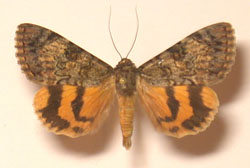
| Catocala desdemona; 55-70mm. Fw gc is light mottled grey with greenish blue cast. Double reniform spot brown. Subreniform spot large, lighter brown, closed; tail extends to pm line. Upper pml teeth moderately produced, next two teeth, not at all. Next produced, thick, rounded, distinct inward loop below. Hw ib turns 90 toward im. Ob broken; large orange apical area. |
Midsized Orange-Salmon-Red-Scarlet Underwings: Wingspans: 50-72mm
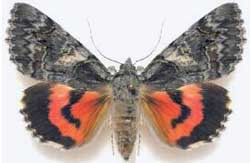
| Catocala ophelia; Ophelia Underwing: 52mm: Fw dark grey, am/pm lines relatively smooth except for two jagged spikes in pm near apex. Considerable brown shading outside subterminal line. Hw pink-deep red, black median band constricted in center, ending before im. Black submarginal border is quite broad near apex. White fringe heavily checked. |
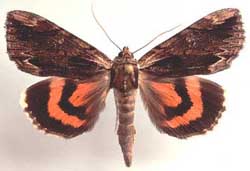
| ** 8857 Catocala ultronia; Ultronia Underwing, wingspan: 50-63mm.Fws typically gray-brown, with a distinct and very dark inner margin and characteristic light brown patch, underscored by very dark arc, near wingtip. Underwings can be yellow to orange to salmon. |
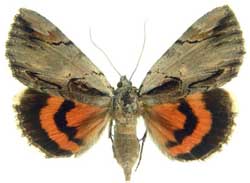
| ** 8857 Catocala ultronia form lucinda; Ultronia Underwing, wingspan: 50-63mm.In form lucinda most of the forewing is bright grey. On all forms there is
extensive orange-salmon colouration on hw ventral surface,
and there is a dark discal lunule. |
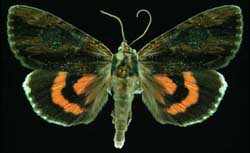
| Catocala ultronia, form nigrescens, the Ultronia Underwing, wingspan: 50-63mm. In the melanic form nigrescens, the dorsal forewing is very dark. Even darker subapical arc, basal dash and dash near anal angle are still visible. Dark basal hairs on hindwing. Harold J. Vermes slide, used with permission from his son. |
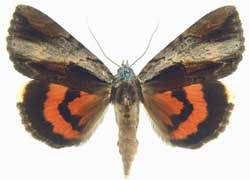
| Catocala ultronia form celia.
In form celia there is a wide, light grey band separating a dark region along inner margin and
a dark patch near the apex.
The ventral surface of forewings of all forms has a generous suffusion
of orange-salmon scales in the lower half of the median area. |
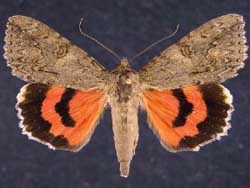
|
faustina;
58 mm |
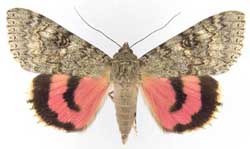
| Catocala hermia; Hermia Underwing: 58-68mm; pinkish: Fw almost uniform, grey-brown or clay coloured; thin, yet contrasting lines. Distinct large double reniform spot. Large concolourous subrenifrom spot usually open. Hw pinkish red, relatively even, narrow black bands. Inner black band ends before im. Fringe white, checked, pink/red "bleeding" along outer band, near apex. |
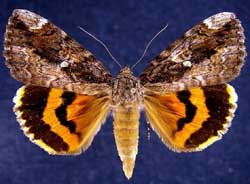
| ** 8770 Catocala innubens; Betrothed; 55-72mm. Forewing is mottled with white, grey and brown, and subrenifrom spot tends to be lighter in colour, although it is sometimes obscured by an indistinct blackish bar which runs from middle of basal/thorax connection to just below much lighter apex at outer margin.Jim Vargo image. |
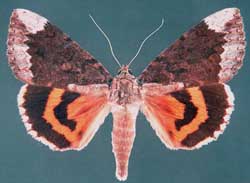
| ** 8770 Catocala innubens form scintillans; Betrothed; 55-72mm.In form scintillans most of the basal area (all but lower third) and all of the median area of the forewing is dark reddish brown. The area outside the pm line is grey. Vernon A Brou image. |
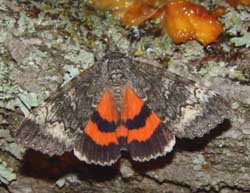
| #8817 briseis; Briseis Underwing; 60-70mm; Fws predominantly mottled dark-grey-brown with some lighter areas 1) between postmedial & subterminal lines, 2) at base of am & pm lines along inner margin, 3) over subreniform spot running diagonally toward costa. Pm lines do not have greatly elongated and sharly pointed "teeth" near apex. Hw fringe white & unbroken, inner black band (fairly even) reaches inner margin. Tim Dyson image. |
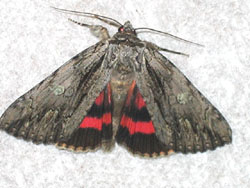
| ** 8851 Catocala coccinata; Scarlet; 57-70mm: Diffuse basal, anal dashes on otherwise light grey, mottled fw. Hw fringe white (often with some salmon scaling); heavily checked. "Tooth" just below pair of very elongated "teeth" is much reduced, quite rounded, usually allowing considerable room for lighter patch of scales. Dark bar crosses thorax. Reniform spot: light, often with greenish cast. Joe Garris image. unconfirmed |
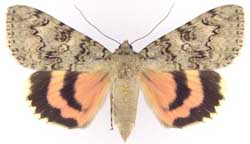
| ** 8808 luciana; Luciana Underwing, 57-68mm. Pale grey brown forewing with very distinct am & postmedial lines. Subreniform spot has elongated narrow "tail" that seems to open through postmedial line. Inner black band of hw does not reach inner margin. Fringe is checked and paler (almost yellow) than salmon ground colour. |
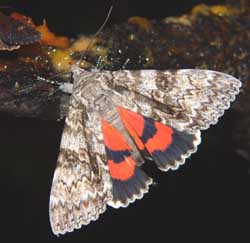
| ** 8821 semirelicta; Semirelict Underwing; wingspan: 55-65mm. Fw ground colour white with dark lines and shadings. Diffuse dark bar runs from center of basal area to outer margin a few mm above anal angle. Note regular dentation of st line. Inner black bar on lower wing usually terminates well before inner margin. The form "atala" has forewing that is uniformly grey. Unijuga is usually larger and has less contrasting black lines. Inner black bar on unijuga usually reaches inner margin. Tim Dyson image. |
Large Orange-Salmon Underwings: Wingspans: 65mm, usually 70-95mm
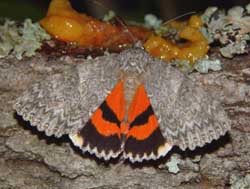
| ** 8822 meskei TM; Meske's Underwing; 65-75mm. Fws less distinctly marked compared to unijuga, some red-orange at the hindwing apex and just inside the fringe along the outer margin in meskei that is lacking in unijuga. Fw subreniform spot is opened or connected to the postmedian line. The hindwing postmedian band nearly straight, turned in and tapering near anal angle. Tim Dyson image. |
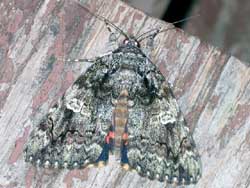
| ** 8801 Catocala ilia; Ilia; wingspan: 65-82mm. Several different forms, most have characteristic white area in and around reniform spot. Diffuse dark arc running from this spot to just below apex. Subreniform spot squarish, concave inner and outer edges and elongated constriction connecting it to pml. White dots near fw om in character with the overall "contrasting" appearance. |
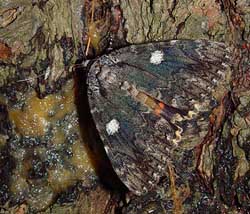
| ** 8801 Catocala ilia; Ilia; form conspicuaIn this form the entire reniform spot is heavily suffused with white scaling on an otherwise darker ground colour. Hence the form name "conspicua". Tim Dyson image. |
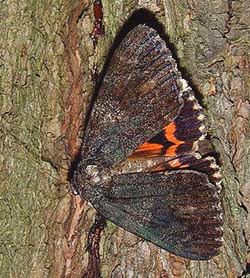
| ** 8801 Catocala ilia; Ilia; form satanasIn this melanic form the entire forewing, including the reniform spot is very dark. Hence the form name "satanas". The dark basal streak is still evident on this form. Tim Dyson image. |
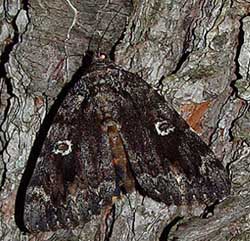
| ** 8801 Catocala ilia; Ilia; form normaniIn this semi-melanic form the entire forewing, excluding the reniform spot, is relatively dark. The brownish, kidney-shaped center of the reniform spot is outlined in white. The basal streak and subapical arc are still visible. Tim Dyson image. |
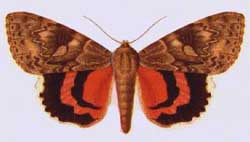
| Catocala electilis; Fw dark grey. Black pm line thin but distinct; two upper teeth not greatly produced. Reniform spot dark brown; large, pork-chop shaped subreniform spot lighter brown extends to pm line. Brown shading in subterminal area. Hw salmon (orange to red). |
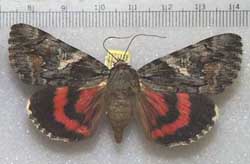
| ** 8833 violenta Violent Underwing (70-80mm): Two elongated, well-defined spikes high in the postmedial line extend to subterminal line. Next tooth is very short. There is considerable brown shading on the forewing between the pme and st lines. Subreniform spot is light with light bar extending obliquely to the costa. |
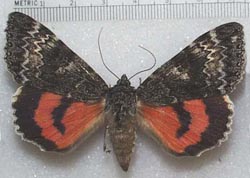
| Catocala grotiana; Grote's Underwing: 70-80mm: The white outlines outside the postmedial and inside the subterminal lines make this species stand out. The hindwing inner black band is even and relatively thin and terminates well before the inner margin. The fringe is heavily checked and charcoal grey along the inner margin. Hindwings can be orange or red. |
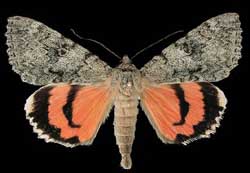
| Catocala junctura; Joined Underwing; 67-85mm. Fw is usually dark brownish-gray to evenly powdered blue-grey w/o significant markings. Doubled reniform spot often obscure. Thin, slightly darker am and pm lines run from costa to im, not widely spaced at im. Hw salmon/ orange-pink, narrow inner black band turns in sharply, does not meet dark-haired im. |
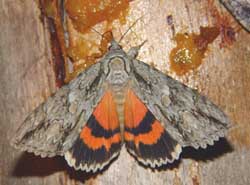
| ** 8806 Catocala parta; Mother Underwing, wingspan: 70-85mm. The black dashes in the basal, subapical and anal areas help to identify this species. The hindwings may be yellow to yellowish-orange but more often are salmon-red. Note the face-head-like markings on the thorax. In the hindwing, the first (nearest the apex) black protrusion into the white fringe is "noticeably" larger than the others. |
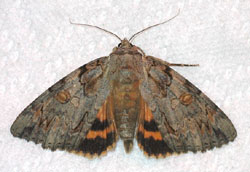
| ** 8798 Catocala neogama; wingspan 70-85mm. Brown head, thorax, larger size as compared to C. palaeogama. Neogama tend to be slightly smaller than subnata, have darker grey brown fws with more pronounced markings. Examination of hind tibia needed for id. Neogama's: flattened, unevenly, sparsely spined; subnata's: cylindrical, spines dense, uniform in distribution. Joe Garris photo. |
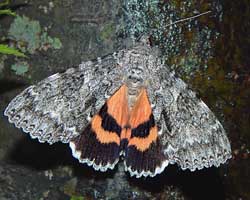
| ** 8805 unijuga; unconfirmed Once-married; wingspan: 70-90mm: Catocala unijuga has a fairly wide black inner band (almost reaching inner margin) in hindwing and very distinctive patterning in forewing. Meskei tend to have narrower band and dustier (less distinct) looking forewing. Semirelicta tend to have inner bands that terminate well before inner margins. Also note the very white fringe on both the forewings and hindwings. |
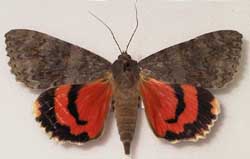
| Catocala texanae; 85mm; The forewings are a mottled grey-brown with indistinct lines.The inner black band of the hindwing is very narrow and comes to a point far short of the inner margin. The hindwing fringe is mostly white with some red-orange at the apex. |
Large Black Underwings (Banded): Wingspans: 70-80mm
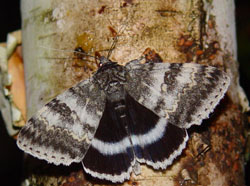
| ** 8803 Catocala relicta
;
Forsaken, White, Relict; 70-80mm:
Considerable variation with regard to black/white
concentrations on fws. |
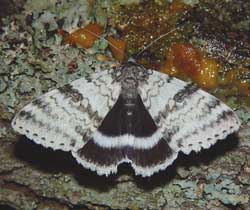
| ** 8803 Catocala relicta ; Forsaken, White, Relict; 70-80mm: Considerable variation with regard to black/white concentrations on fws. Form clara: basal and subterminal areas predominantly white.Typical specimens have basal and subterminal areas with blackish scales. Black hws, with brilliant even white inner band and white fringe, are distinctive. June until October. |
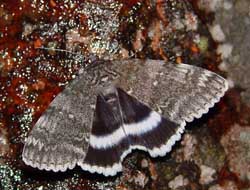
| ** 8803 Catocala relicta ; Forsaken, White, Relict; 70-80mm: Considerable variation with regard to black/white concentrations on fws. Form phrynia: evenly dusted with grey over entire forewing. Typical specimens have basal and subterminal areas with blackish scales. Black hws, with brilliant even white inner band and white fringe, are distinctive. June until October, poplars and willows |
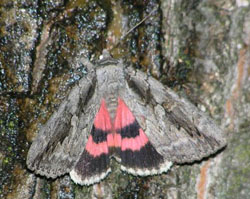
|
** 8834 amatrix Sweetheart Underwing; (wingspan 75-95mm). Very skittish, frequently hides in caves, under bridges, under tree bark, etc. by day, resting with head down. Hw patterning and colouration similar to that of C. concumbens, but large size (wingspan 75-95mm) and dark bar running from basal area to just below apex distinguishes C. amatrix. See large Catocala amatrix courtesy of Joan F. Rickert. |
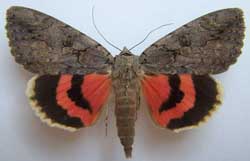
|
** 8834 amatrix form selecta
Sweetheart Underwing; (wingspan 75-95mm) |
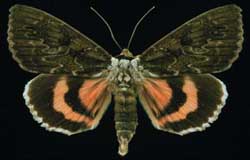
|
** 8834 amatrix form hesseli
Sweetheart Underwing; (wingspan 75-95mm) |

